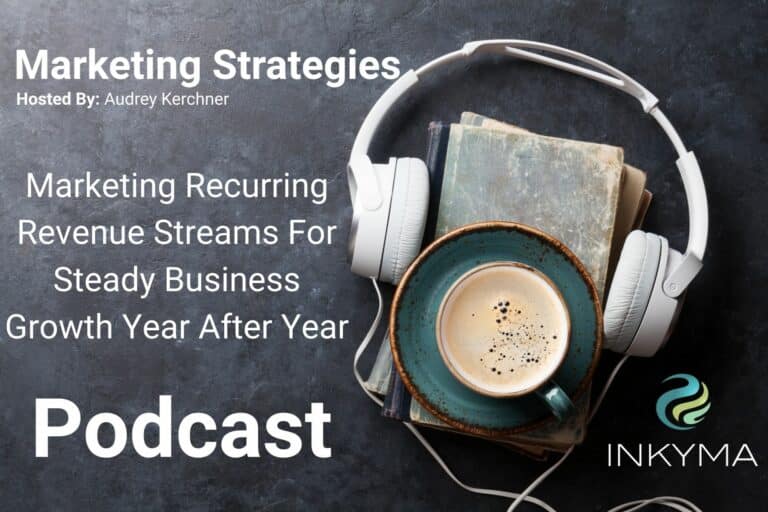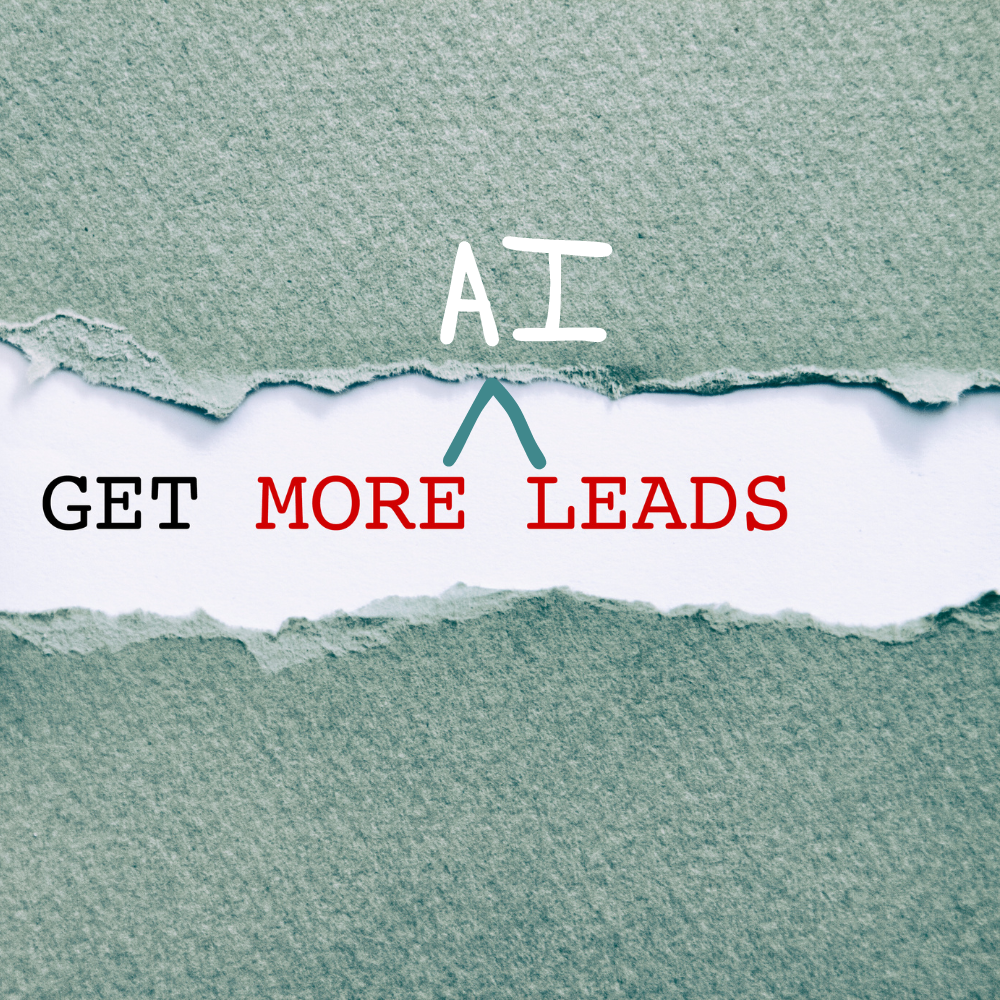On today’s episode we are going to dip our toes into the world of recurring revenue streams and how to market your business for steady growth year after year. You can’t plan for the future if you can’t count on a certain amount of revenue today. So join Audrey Kerchner while she breaks down the grey areas where business and marketing strategy meet and how to develop a steady income for growth.
Links Mentioned In This Episode:
Marketing Recurring Revenue Streams for Steady Business Growth Year After Year Transcription
Audrey Kerchner:
For many small business owners, consistent revenue every month is a bit of a unicorn. There’s a lot of fluctuation. As I’m sure all you business owners know, sometimes you have up months, sometimes you have down months. You can call it feast or famine. And then with that feast or famine comes a lot of stress, not knowing where your income’s going to be. Can you cover the monthly cost? Are you going to have that extra money that you were looking for?
But wouldn’t it be great if you, as business owners could count on a base income that comes in every month, hit your account first of the month, 15th of the month, almost like a traditional employee paycheck? Well, so here’s some good news. In a way, you can and you do it with reoccurring revenue programs. And that’s what I’m going to talk with you about today is the different types of reoccurring income programs that you can put together for your business and how you can market them.
Announcer:
Welcome to Marketing Strategies with Audrey Kerchner sponsored by Inkyma, taking your small business to the next level with proven creative solutions designed to grow your awareness and connect to your customers. Now, here’s Audrey.
Audrey Kerchner:
I’m Audrey Kerchner, Co-Founder and Chief Marketing Strategist here at Inkyma. Inkyma is a full-service marketing agency and we bring that big agency feel and process and support to small and midsized companies. To learn more about what we do, ask a question or to schedule a marketing evaluation for your business, go to our website inkyma.com. That’s I-N-K-Y-M-A.com.
If you’re a new listener or a returning listener, welcome. I’m so glad that you’re here and I hope you’re going to find this content extremely helpful. If you want to listen to past episodes, we are on all the podcast platforms. Just go do a search for Inkyma and we’ll come right up. We also have all of the episodes on our website and on our YouTube channel.
Recurring revenue programs. Is it a business strategy? Is it a market strategy? The answer is yes. It’s actually both. This is that gray world where business strategy and marketing implementation strategy kind of live together. Technically, it’s a business strategy because you say, “Hey, I want to have a recurring revenue program” and you decide, “Okay, this is the product. This is the service. This is what I’m going to do,” but then you have to create awareness for it. You have to put it out to your current customers, to new customers. And that’s where it becomes a marketing strategy. How do you do it? How do you present it to those folks to make it palatable for them to want to sign up and do this?
And so that’s why I’m talking about this. I’m talking about it and I’m going to talk about the business-y piece of it. And then I’m also going to talk about how you create the marketing strategy so that someone goes, “Wow, that’s a really good deal or that’s something I want to sign up for. Let me do that.” So we’re going to talk about pricing, selling strategy, and the best way to do this in whatever the current social climate is that your business is in right now.
So, what is a recurring revenue program or strategy? Well, it’s a selling strategy. You have products, you have services, you can sell it once, or you can sell it multiple times over multiple months or over multiple years. So it’s a monthly type of program versus a one-time cost program. And so some other ways to think about it and I’m going to come back to this often is you’re giving access to a product service in exchange for a fee at regularly scheduled intervals. That sounds like a lot, but we’re going to kind of step through this a little bit.
So more importantly, “Yeah, that’s great. I sell a product. I make it monthly. Why? What’s the big deal?” So the why is really steady income that a recurring revenue program can bring is the key to business growth. It’s the only way a business is going to grow. When you can plan for the future based on money that you feel very confident is coming in, it might fluctuate here and there every month, go up a little bit, go down a little bit. But if you know you can count on it, then you can plan for the future.
Let’s take an example of how this looks and let’s talk about sales cycle time for a new client for a single purchase, one-time purchase versus a reoccurring revenue cycle for a person. So let’s say you get a new client and they purchase one thing from you and let’s say they do that in December. It’s the holiday season, they’re buying this one product from you. That’s great. You get the sale. You’re really happy. And then come January, you don’t hear from them again. You may not hear from them again until July when they feel like they need whatever that it is again or you may never hear from them again at all. Because whatever product or service you’re offering, they forgot they bought it from you and they’re going to someone else because they saw their shiny bell and whistle in March or April after that December purchase.
Now, let’s say you get a brand new client and they sign up for a subscription service that provides that exact same product. It’s something that goes out monthly. They sign up for a six-month program, and then you’re getting that money that comes in January, February, March, April, May. And then also they’re getting to know your brand because they’re seeing your email, they’re seeing that box show up. They’re getting the telephone call from your company, and then they could sign up for another six months for very little work on your part.
And the benefit for them is that it’s just kind of showing up and it’s not requiring them to do any extra work or very little focus on their part. So what this means is with a recurring subscription-based type of service, you’re getting higher customer retention rates and you’re reducing purchase fatigue. They don’t have to go in and hit that buy button over and over. They don’t have to go back and find you over and over. It just seamlessly shows up.
The other thing that I think is important is when you have a subscription service depending on what you have, let’s say it’s a high-ticket item. When you push that out across many months or years of purchasing, you’re making your product or service more accessible to more people. So instead of having to lay out $2,000 right now in this moment and your service, the subscription that you’ve put together allows that to be pushed out across 12 months, six months, more people are going to be able to do it because it fits within their financial budget.
And a good example of this is and I can already hear the groans is look at your cellphone. Did you pay for that all at once or is it built into your reoccurring cell phone bill, and it’s just an extra $10 or $15 a month over two years until you get the next one? People will buy a more expensive phone because it’s more accessible from a cost perspective. They’ll do 15 versus $12 to get the nicer version of the iPhone that they really, really want versus having to shell out 800 versus $1,200 all in one shot. That’s a bigger span of the bucket and so that’s why these wireless companies do this is because they know they’re going to get the bigger purchase item because it’s just fractional dollars month over month.
So, let’s talk a little bit about how this is going to work, how our reoccurring revenue stream creates a steady income. We’ve touched on it a little bit, but I want to go a little bit deeper. You get that customer, they purchase a product servicer once, and then you’re hoping they come back. Hope is not a marketing strategy. If you create that recurring program and they sign up for it and they like it, they enjoy the service, they’re going to definitely keep signing up or re-upping. Or if it’s an evergreen program and we’re going to talk about different types of programs, they’re just going to keep letting it go, let it debit their card and you keep sending it.
So now I want to share an example with you of how this works in a non-traditional type of company. Because I really feel a recurring revenue program works for any business. You just got to think it through and figure it out. One of my favorite companies is a hair coloring kit company where they send you hair color in the mail and you dye your own hair. Men, women, they’ve got everybody covered. Actually, the name of the company is eSalon If you want to go look them up from a case study perspective. This isn’t just something I’ve made up in my head.
So, what you do is you sign up with them, you go through this survey, this quiz, you send them a picture of your hair. You figure out what you want your hair color to be. They assign you to a hair color specialist who will then create a custom color for you based on what you want and then you sign up for their monthly … It’s not a monthly subscription. You set how often it comes to you. Do you want your hair color every four weeks, five weeks, six weeks? It automatically ships and then you’re done until you decide to change your hair color again.
And then the other great thing is that they have a bunch of different hair products and services that you can have put into your box when it ships out. So if you need shampoo, if you need moose, if you need gel that’s specific for your type of hair color, you just say yes, add it to my box and it’s going to show up. And then that can come every month or every two months. It’s a really sophisticated program that they’ve put together for this. But you can see how instead of a company like Clairol where it’s like, okay, they’re going down the aisle, they pick the box that they think is going to look good, they put it in their cart, they have a good experience, they have a bad experience and maybe they don’t do it again. Maybe they forget.
This, it’s just super easy. No buying fatigue here. Do your hair and you know that whatever that timeframe is you picked, five weeks, another box is going to show up, and then you do your hair at home. Extremely convenient. Plus, they got videos on how you do it. They have support. All this really great stuff. And so they’ve created this wonderful recurring program where they know what their monthly is going to be at the beginning of every month and then boom, boom, boom, everything’s going to hit. So hopefully that example really hits home on how this is going to work. And now that you understand the benefits, why this is so great for your business, I want to talk to you about the different ways that you can implement this for your business.
You’re listening to Marketing Strategies and I’m Audrey Kerchner. And we’re talking about reoccurring revenue programs to grow your business. If you have a marketing question, if you want to suggest a topic, you can submit that on the website, inkyma.com, I-N-K-Y-M-A.com. Go to the bottom of any of the pages, there’s a contact form, fill it out and I will actually respond to it personally.
So now let’s talk about what you’re going to do from a reoccurring perspective and how you can market it and what the important pieces are to market it. So I want to start out by giving you the top three recurring revenue models that exist. There are different ways you can slice it and dice it and talk about it. But as I was going through and looking at all these different companies and researching like what they actually called, I kind of came up with three basic ones. So let’s talk about a traditional basic subscription program that has been around forever. I’m talking about you sign up and you get sent something monthly or weekly. Think magazine subscription, think newspaper subscription. Some of those are daily. You pay monthly and the newspaper gets sent to your door every day. This has been around forever.
The newer ones that have taken up this model are the box of the month club. Let’s say that you are shaving or like I said, coffee. There are sites out there where you can get a box subscription for pretty much anything under the sun, including your favorite TV show. My husband signed up for a Firefly subscription that comes three times a year and he gets memorabilia and he gets hats and he gets mugs and he gets statues. And any of the Marvel products have something like this out there.
The other one is Amazon, your Prime. Your Prime subscription is a reoccurring program that Amazon just gets no matter whether you use it or not, and we all use it. So that’s where I want your headspace to be. So the types of businesses that would do just wonderful and beautiful with that traditional subscription are any type of e-commerce business. If you’re selling one, why not sell a box of them? Retail stores, same thing. You could have a box of the month club if you’re brick and mortar and just ship things out. You’re not going to total e-commerce if that’s not the way that you want to move your business or they can come pick it up. Have a pickup party once a month.
Hair salons talked about the eSalon model. Traditional in-person hair salon companies can do the same thing. Nail salons, they can do something like this. Dog groomers, auto care, dentists. You got to go to the dentist every so often, but they can make a program out of it. The next program is a usage-based subscription, the auto-renews. Think of it as a credit-based subscription. And the one that stands out for me the most that I think most people would be familiar with is Audible, which was bought by Amazon a couple of years ago where basically you buy a subscription where they give you credits towards audiobooks that you then purchase with those credits and the credits have a significant discount versus just buy the book outright.
So you own the book, but it’s a subscription service and you have to use the credits, but the credits renew often. Take a look at it. It’s a very interesting and sophisticated and elegant model that they put together. But if you are an audiobook consumer, it is a great program to do because everything under the sun is there, and you’re getting it at a significant discount versus just buying it outright.
The other one that a lot of people may not think of is gyms. Yeah, gyms will follow under the next category I’m going to talk about or the subscription category, but they also follow under the credit-based. I’ve seen quite a few gyms where it’s like for $10 a month you can come to the gym 10 times per month versus the 40 or $50 per month for unlimited usage. So they offer different tiers. And so this credit-based for classes or for group things. So this credit-based model where you get to step down the price a little bit makes it more accessible to someone who doesn’t want to spend that higher price. So they’re doing it as a tier system, which is really cool.
So the types of businesses that this would be really good for, any service or product that you can purchase on a credit basis. Here’s an example, a nail salon. Anyone who gets their nails done regularly, they would love something like this, where you buy six manicures that are good for six months and it auto-renews so they’re paying for it twice a year. They’re getting a discount on the manicure from when if they just walked in whenever they felt like it or scheduled an appointment, and you can put little freebies in there. Like if they get acrylic nails, you can give them free fill-ins in between having to replace the acrylics or you can give them a free pedicure every year. And they’ll find that to be an advantage because if you get your hands done, a lot of you get your toes done a couple of times a year.
Now, let’s talk about the last segment that I have, which I like to call or I’ve heard other people call the evergreen subscription or membership. The other way to think about this one is that people prefer to pay for access rather than ownership. Think about that. They don’t want to own it, they want access to more for what they’re paying for. So I’m going to say two things to you and then hopefully this will all be clear. Netflix and Spotify. We don’t buy movies anymore. We have a Netflix subscription. We have an Amazon, we have a YouTube subscription. We pay for access. That’s what Netflix is; same thing with Spotify.
All that music, you’re not paying 99 cents a song anymore. You’re subscribing for the month and you’re listening and changing out and downloading whatever you want. So this particular model because of Netflix and Spotify has become overwhelmingly more popular. Gyms, they’ll do the same thing. That’s what I talked about before is you can either buy a couple of credits, $10 for 10 sessions, or $50 a month unlimited. Come in as often you want. Use whatever equipment you want. We don’t care. You paid your fee, knock yourself out.
So this type of evergreen or access subscription is really great for software, for apps. Something else that’s local that people don’t think about is car washes. You can create a subscription program where you charge X number dollars a month and they can come and get their car washed anytime they want. And realistically they’re probably going to do it once a week. So you price it out accordingly, but they’re going to be like, “It gives me access to the car wash for whenever I want.” And if they’ve got three cars, it might work out really well.
So that’s where that Netflix model can carry over into a car washing service. So these are all just different ways to think about the same thing, which is a reoccurring revenue program. The big takeaway I want you to take away from this is that people are really okay and they actually prefer that access versus ownership type of model. Don’t think that, “Oh, well, they could just buy it once. Why are they going to sign up for ongoing access?”
The model is proven out now. Look at Netflix, look at Spotify, look at your Gmail account. Granted, we don’t pay for Gmail, but you don’t own the Gmail software. It’s not downloaded to you. It is cloud-based and you’re using it. And all of your emails forever, how long you’ve had the account are sitting up there and you could download those emails and print them out and yeah, they’re yours, but the system is not yours. You’re granted access for free and there are paid versions of that Gmail account too. So we are totally okay with this 100%.
Another out of left field, I’ll call, it type of example I want to share with you and I don’t know the name of this company. I have seen them a couple of times. I was super interested in it, but it’s actually you can rent a wardrobe. You can pay a monthly fee and get access to a revolving wardrobe. They will send you shirts and pants and dresses and shoes and purses. And when you’re bored of them, you send them back and you get new ones. This is great for fashionistas or anybody who gets bored with their wardrobe. Or if they’ve got just a closet full of clothes that they just don’t wear anymore and you can size them up and size them down. So it’s taking that buying and holding model and turning it into an access model for an industry that you wouldn’t even think of.
So really think about that for your industry. Can you see where someone would just pay for that access for the convenience of it? So now that we’ve walked through that, hopefully, you’ve got some ideas and you’re inspired to create a program that meets your needs, but how are you going to drive awareness? You need to create campaigns and marketing and tactics to drive awareness. So I want to talk to you about that for a little bit. So here are the type of things that you can do.
And if you listen to any of the past episodes, this is not going to be new information for you. Because campaigns and tactics are campaigns and tactics. It’s what you put into them that makes them different, unique, and effective. But let’s talk about tactics first. So you can do digital ads that link to a landing page where you collect billing information and you get them to sign up right away for the service. You break right through that first barrier and that landing page can be used for multiple things. The landing page is really your house and all these other things are the cars that are driving to the house.
Another thing you can use is sales funnels. You get them to sign up for the plan for sure, but you also create these automation email sales funnels to keep them on the plan. If you listened to any of the retention programs that I’ve recently done, this will sound really familiar. So let’s take that eSalon example I talked about at the top of the show. They have an amazing email automation system set up to keep their people, their clients, their customers on the plan. Every month they get an email saying, “Hey, we’re getting ready to create your custom hair color. Do you need to chat with the specialist? Do you need extra product? Here are some different things you can add to it.” And now is the time to do that.
Then you get another email saying, “Everything’s been created.” Hey, guess what? It shipped and boom, it shows up on your doorstep within a couple of days. So there’s like this whole series of emails that goes out that gets you excited about, “Oh look, my package is coming.” You get that Amazon effect after you’ve hit the buy button, but you don’t have to hit any buttons, it just shows up for you. And then they send emails out about brand new products. They’re constantly working on and creating for all of your hair care needs. And it’s like the ta-da, we’ve just come out with this new thing.
So sales funnels, automation, yes, but not just to get them to sign up, to also keep them especially if you’re in that evergreen mode. And to that effect, email newsletters are a really nice way to do that. So from that eSalon example, those here are our new product, here’s hair care tips for the fall. They do that in email newsletter form. Social posts, absolutely. You can create a Facebook group for all your existing clientele and you can talk to them directly inside of that.
And we’re savvy enough to know the difference between someone that we followed their page and it’s going into our regular feed versus it comes from a group. There’s more trust in groups. And Facebook is actually protecting that trust by not letting advertisers do certain things with those groups. They can’t target groups. You can’t do certain things. You can only post into a group if you’re a member and they’re moderated by human beings. So consider creating a group because then that keeps that trust factor really high.
And I’ve done a show and interviews before, network, networking meetings, building your networking, going out to your network, utilize that. That is actually part of your marketing mix. So now let’s talk about what to put in this stuff. If you’re going to do an email campaign, a digital campaign if you’re going to create that Facebook group. So language and images are really, really, really important when you’re putting this together and what you want to stress when you’re trying to get people to sign up for this is the benefits and the value, not only of the product or service that you’re selling but the benefits and value of the program. Why it’s more beneficial to sign up for the recurring program than it is just to buy it as a one-off.
You have to get the program to solve their problem. Is it ease of use like the eSalon model? Is it something that you buy frequently like manicures where you’re actually getting a discount if you sign up for the program and you’re getting your freebies that you would’ve paid for anyway? Make sure that that is simple and crystal clear, and then ensure that your videos and/or your images support that. That’s really important. Don’t talk about the product. Don’t talk about your company. Talk about the benefits of signing up for the recurring program.
So let me give you another example of that. Let’s talk about dog grooming because I’ve talked about this in the past. I think it’s a great example because it’s very nontraditional. People that get their dogs groomed often, what you do is you sell them a package over a certain amount of time. It can be evergreen. It can be credit-based, but it’s at a reduced price. So if you’re selling a dog grooming for $45, as part of their program they’re getting it for 40 or $38. And they get priority scheduling, especially during busy times around the holiday seasons and on the weekends. And then you can throw other freebies in there like they get a free nail clipping once a quarter. You throw into the bag when the dog goes home dry shampoo for you to use in between.
You treat them like they’re really special because actually for you they really are because they’re the ones that are helping you grow your business more so than the guy that shows up once every six months with their dog covered in mud. All right, so hopefully you’ve got those creative juices going in your head. Now I want to talk about taking action because this is only going to be useful if you actually do something with the knowledge that you’ve just obtained.
So the first thing I want you to do, decide on what type of recurring revenue program you want to create, lay it out step-by-step. It’s going to be this product or service. It’s going to be this type. It’s going to be an evergreen. It’s going to be a credit-based campaign. What are the incentives for using it? What are the cost savings? Lay all of that out. Get your staff involved too. You’re going to be the best one to figure this out because you know your business really well and you are the subject-matter expert.
Once you’ve laid that out and figured it out, now it’s time for the marketing side of it. What campaigns or tactics are you going to use to drive awareness and to drive sign up? Start with one, make it simple. If you have a really robust email program that you use for your single or one-off purchases or for your general marketing awareness, flush that out. It’s what you know best. And then you can figure out how you’re going to do all of this. Then once you get comfortable, then you can add in digital ads, then you can add in the Facebook group. Grow upon your success, but start with one.
And then the last thing I want you to figure out and really spend a lot of time on this is what is your language going to be? What’s that value proposition for the program, for the service? Make sure you spell that out and then pick images, pick video that actually supports that language because people are going to glance at that first to get the inkling of what you’re trying to do before they’re going to go through and read. And then keep the copy brief. This is where or copywriting gets a little tricky. Anybody can say what they’re trying to say in 400 words. It really takes time and effort to do it in three sentences.
All right, so here are my final thoughts on this whole topic. Recurring program campaigns, they really are just like regular campaigns. So if you’ve listened to any of the past shows about campaigns and I walk through all of those, all of that is applicable here. It’s what you’re offering that’s different. It’s not, “Hey, buy this product. It’s, “Buy this service, and here’s why.” And just like with any type of campaign, you need to review your data after you’ve launched and then you need to tweak your program and your campaigns. Also, consider A/B testing different images, different languages, different benefits. Maybe the benefit of cost reduction isn’t as good as the freebie that you throw in. You’ve got to test those different things.
So treat this like you would any other campaign that you’re putting out there. And then I think once you get all of that locked in, you’re going to be excited because you’re going to see not just revenue come in, but reoccurring revenue. Meaning, “Okay, they’re on monthly billing.” And then the first of the month comes in and all these invoices just shoot out of your system and your revenue just goes up within hours, which is really, really cool. And this is going to energize you to do more. So after you get that first program out, what else can you do, right? What other recurring revenue? It’s okay to have multiples. You don’t have to have just one and so that’s where I’d love to see you in a year from now.
Here at Inkyma, we like to give back to the business community. I provide a free 45-minute marketing consultation to any business owner, whether you’re trying to launch a single product or you’re all in on this recurring revenue program idea, we can talk about that. Just go to my website, inkyma.com. I-N-K-Y-M-A.com. And in the upper right-hand corner, there’s a button for you to schedule a marketing evaluation. Just click on it, pick your time and we are on the schedule together.
If all you have is just a quick question, go down to the bottom of the page and there is a contact form there, type your question in, and I will personally get back to you. So I hope you found the information in this episode informative and helpful. If there are other business owners that you know that are probably struggling with that yo-yo effect of revenue every month, please share this podcast with them because really what we’re trying to do here is to help all businesses grow so that we can all be successful and thrive. Thanks for listening and have an amazing day.
Announcer:
Thanks for listening to Marketing Strategies sponsored by Inkyma. Online at I-N-K-Y-M-A.com. Listen to Marketing Strategies every Saturday at 7:30 on KPPF.



























